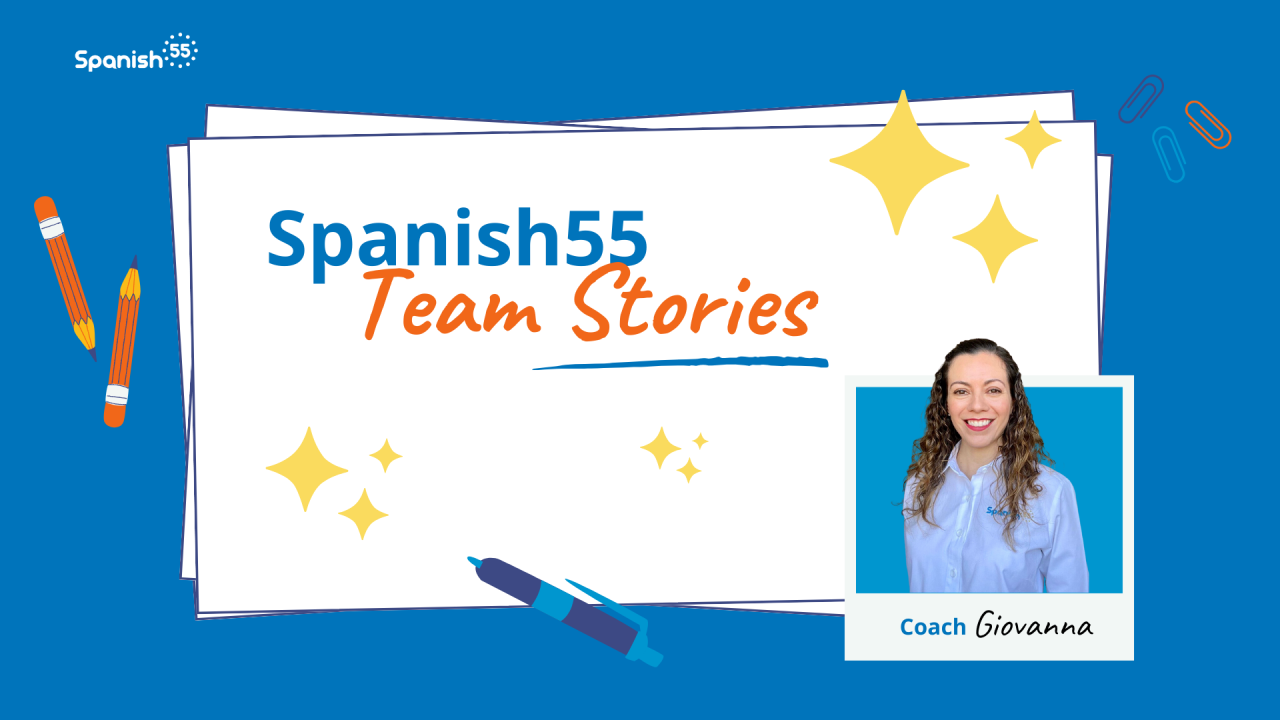3 Spanish Teaching Methods That Actually Work for Fluency!
The objective of teaching is to produce learning. Knowledge of the process of learning makes Spanish teaching effective. Like everything in life, teaching methods are not static and have evolved based on research and the need to communicate effectively rather than learning just the grammar or memorizing dialogs or phrases. In the past, learning Spanish was viewed as a process of habit formation. Step #1, the students learned a grammatical rule. #2, the students practiced exercises. Step #3, the students produced correct sentences. Mistakes were avoided and learning was seen pretty much "under control". While grammatical competence is an important aspect of language learning, there is much more involved. You want to learn Spanish to have meaningful communication, not to pass written tests only. That's why here at Spanish55, we introduce you to 3 different Spanish Teaching Methods that actually work for fluency!
Introduction to a few language concepts

Source: Unsplash
Before dealing with different methods and approaches, let's deal with the concepts that Edward Anthony, an American linguist developed in the '60s. Approach: This concept refers to the nature of language teaching and learning. Covers both linguistics and psychology. Defines the "what" and "how" of Spanish teaching. The approach leads to the method. Method: Deals with the plan for the presentation of the language material based on an approach. The theory is put into practice. Here, choices are made about how the tutor will teach a particular skill. Design: Gives details of a method. The tutor decides the objectives, contents, and syllabus. Also defines the roles of the tutor and the student. Technique: Is the tool to implement the method. It can take many forms such as role-plays, drills, games, Spanish through songs, etc.
Brief Review of Spanish Teaching Methods
Grammar Translation Method
This method ruled the language teaching a hundred years ago but is still popular. It focuses mainly on the study of grammar following translation. Earlier, it was aimed at the study of the literature of foreign languages through analytical skills. This method puts emphasis in translating from source language to target language and vice versa. Learning vocabulary items based on reading the text, applying a deductive analysis. If you wish to learn grammar, we recommend free grammar lessons by SpanishTutoring.com How can this method benefit your Spanish learning? You can pick up some vocabulary based on the texts that you are interested in and learn some grammar rules that will be repeating constantly along with the text, this helps you as a form of practice. Why this method is not the most convenient? There is no interpersonal communication and while you may be able to understand and use the language in a written form, you will have no exposure to spontaneous speech. You won't be able to use the language though you know the rules. But of what use is to know all the rules if you can't speak Spanish with a native...
Oral / Structural Method
The main focus of these methods is vocabulary and grammar control. An important skill was reading along with controlled vocabulary based on frequency. This led to the design of the syllabus in language teaching. The approach was a repetition system of grammatical constructions from simple to complex. One subdivision of this method became the audio-lingual method that empathized oral proficiency through listening to tapes and cassettes with phrases and grammar constructions based in certain situations. How can this Spanish teaching method benefit your learning process? This method pays systematic attention to pronunciation. Through repetition, you can learn the proper stress, rhythm, and intonation of the words and phrases. Why this method is not the most convenient? It is a mechanical method, you become passive. It is confined to classroom drills and has no communicative use in the real world.
The Communicative Language Teaching (CLT) Method

Source: Unsplash
Why this method is the best for learning Spanish?
- Because you learn the Spanish language by doing (follows the cognitive theory).
- You should participate and communicate with the tutor.
- Contextualism is basic requirement to learn Spanish language items.
- The emphasis is on fluency rather than accuracy. We learn from errors; they are an integral part of the learning experience!
- It is a student-centered approach. Your needs are of utmost importance!
- Spanish learning is not getting mastery over single sentences, but to develop an ability to participate in the discussion or in writing.
- The Spanish tutor should be extra resourceful to develop material according to the needs of the learners. The tutor is a guide and facilitator
Want to speak Spanish confidently and fluently?
CLAIM YOU FREE SKYPE LESSON NOW
Purposes of the Communicative Approach
Provide total skill practice. Instead of focusing on partial skills (such as learning phrases), a communicative approach will allow you to learn the "whole picture". Improve motivation. Your ultimate objective is to take part in communication with others. Your motivation will increase when you see the private Spanish lessons align with this objective. The Spanish language is ultimately a means of communication, not only a structural system. Allow natural learning. Many aspects of learning Spanish can take place only through natural processes, that means, only when you are using the language for communication. Create a context that supports learning. A communicative approach provides opportunities for positive personal relationships to develop. When you have a bond with your Spanish tutor, you humanize the lessons and creates a comfortable environment that supports your efforts to learn.
Spanish for Specific Purposes and Activity Types
An important aspect of the Communicative Approach is that recognizes your need to use Spanish in a specific occupational or educational setting. It would be convenient for you to learn the specific kinds of language and communicative skills needed for a particular role (e.g. tourism, business, engineering, etc.) rather than just to concentrate on more general Spanish. Such needs could include differences in vocabulary choice, differences in grammar, differences in the kinds of texts commonly occurring, differences in functions, differences in the need for particular skills. The type of activities to follow are based on an information - gap setting. Normally, you communicate in order to get information that you don't possess. Roleplay, puzzles, games, interviews, opinions are just some of the resources that your private Spanish tutor will provide.
Structural and Functional views of the Spanish language

Source: Unsplash
The communicative approach has two views of the Spanish language; structural and functional. The structural view of the language concentrates on the grammatical aspect of the language. Let's take a look at the following example: ¿Por qué no abres la ventana? (Why don't you open the window?) From the structural view of the language, it is clearly an interrogative sentence. From the functional view of the language, however, it is not very clear. It could be a genuine question or perhaps a request. It could also be a command or even a complaint. A situational context is required to decide the correct function.
Let's review the functional view criteria:
The communicative function of the language. Language is viewed as a means by which humans communicate thoughts, ideas, beliefs, wishes, needs, and desires. It is the primary means of social interaction. The symbolic function of the language. Refers to the function of the language serves as a result of the speaker's attitude about language, that in turn influence norms, standards and models. Individual language user as a social being. The criterion reflects the individualization of the content. This allows the preferences in the use of language, vocabulary, and formality. Each individual use language to establish, maintain and develop membership in a group. Analysis of language in context. Are the forms of the language related to the functional meaning they express? Meaning. The criterion is viewed as the result of choices available to the student or what the student wants to say. Actual texts. Are represented by excerpts of authentic sources such as textbooks, newspapers, transcripts. These texts are spoken and written with the purpose to communicate with other users of the language. Context. This criterion concerns the relationship between form and situation. Is enough background provided about the speakers and hearers for the motivation of their choice of forms and interpretations of these forms to be clear? Situation. Refers to the environment of the speech. The particular characteristics that lead the speaker to formulate or interpret the utterances the way they do. Culture. Its the appropriate use of language. Determining the situation types in which users of a language engage and the forms appropriate to these situations.
Syllabus
Approaches and methods automatically lead to syllabus planning. The process of Spanish teaching and learning cannot be complete without a syllabus. It fulfills the aims and the objectives of teaching within a specific period of time. It is flexible and can be adjustable according to the needs of the learners. Syllabus covers who: the student; why: purpose, aims, and objectives; what: content and material; when: hourly, weekly, monthly, yearly; how: Spanish learning methods and techniques. A Spanish teacher needs all this information before starting teaching in the class.
Conclusion
Language teaching and is always in constant evolution. Some Spanish teaching methods became popular after their use in the military (audio-lingual) or by common tradition (grammar translation) but all of them leaves critical gaps in the student. Students might develop good reading, listening or writing skills, but be unable to communicate meaningfully. Language is created by the individual through experiences and often by trial and error. By using the Communicative Language teaching method you will experience the most complete learning experience ever. Language learning is learning to communicate using the target language and developing skills such as speaking, listening, reading and writing. Students must have constant interaction with and exposure to the target language. Take the next step and meet a Spanish tutor. The Spanish teaching experience will be unforgettable.












